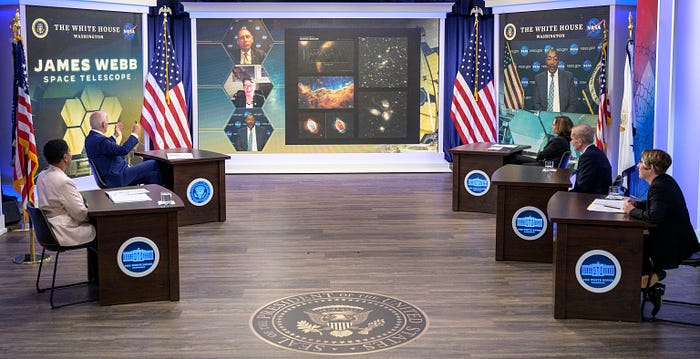From the cosmos to Piccadilly Circus, the James Webb Space Telescope is making science fun again.

Those fatigued by a constant diet of apocalyptic political news predictions and talking-heads apoplectic over some new outrage or another can find solace elsewhere in the universe of news.
Science news rarely disappoints.
Ancient artifacts have been revealed over the summer due to prolonged droughts in some areas. Though many spectacular archeological finds have been discovered over the centuries since Herodotus wrote his histories, plenty of fantastic historical finds remain hidden.
The ancient crowns of early dynastic Egyptian rulers have never been found. The highly-advanced civilization of the Ancient Egyptians lasted for thousands of years. It lasted so long in fact, we are closer in time today to one the last and perhaps best known rulers of Ancient Egypt, Cleopatra- who was a member of the Ptolemy family and Greek- than Cleopatra was to the builder of the Great Pyramids of Giza.
There are a great many crowns depicted in Ancient Egyptian art. Physical specimens, however, have never been found.
Nor has the tomb of Alexander the Great. The conquerer’s burial place remains one of the most sought after lost treasures of history as yet to be discovered.
A close relation to homo sapiens was discovered recently by Chinese scientists. Dubbed “Dragon Man”, it remains to be seen if this specimen will help fill the gaps in our knowledge of human development over time. Until we know for sure, the Missing Link remains missing.
Neurobiologists and neuroscientists still don’t understand why we need sleep, why placebos work on us, or why we age. Things are looking up on that front: Scientists in Israel may have just unlocked the secrets of how to reverse the process of cellular aging.
The seat of the human soul remains a persistent mystery to all and sundry. Brain scientists can find the control room alright; but nobody’s at the controls.
Neurologists of every variety have decades of research to pool at this point, and plenty of computerized power and globalized connectivity to pool it. They’ve gone as far as issuing the Cambridge Declaration on Consciousness but they still can’t find the ghost in our machine.
Scientists still don’t really know how homo sapiens ended up with these haunted thought machines in the first place. Darwin was a keen observer of the natural world, but he was like the kid in class who took attendance and forgot to count himself.
Looking out across the natural world and all its adaptations and wonders- animals, plants, and nature in perfect harmony- one of these things is not like the others.
It’s us.
Human beings.
We’re different. Smarter.
Crows have been known to use crosswalks to crack nuts. They wait for the walk signal to place their nut in the path of oncoming traffic, move out of the way, then wait for the walk signal to retrieve their nut.
An especially smart beluga whale in a Canadian aquarium got incredibly good at mimicking human speech quite a few years ago. So good, in fact, animal handlers at the facility recorded its vocalizations for future study. Eventually, scientists using advanced computers were able to make out the “word” the whale was saying over and over: “Out.”
Our nearest animal relative has managed to use crude tools; some have even been taught- by humans- to use sign language.
Human beings, on the other hand, have produced Picasso, William Blake, Bach, Shakespeare, Kahlil Gibran, Marie Curie, Martin Luther King Jr., Albert Einstein, Aretha Franklin, Mother Teresa, antibiotics, the internal combustion engine and the pentium processor. We’ve split the atom; mapped the human genome.
We’ve explored the deepest depths of Challenger Deep in the heart of the Marianna Trench; we’ve been to the moon.
And now, we’re going even further.
The launch of the James Webb Space Telescope on Christmas Day, 2021, was heralded worldwide by stargazers, scientists and amateur astronomers of every age and description as the dawn of a new age in space exploration.
In the months since, as spectacular postcard after spectacular postcard has been beamed back to Earth with love from the James Webb Space Telescope, everyone has been getting excited about deep space exploration.
From the White House to Times Square to Piccadilly Circus and beyond, Webb has won new fans the world over.

With Webb, humankind will be able to see further than ever before- into the farthest reaches of the galaxy, beyond the familiar planets of our backyard.
But that doesn’t mean we don’t want a closer look at some of our nearest neighbors.

There are some very interesting cosmic mysteries orbiting one of our closest galactic roommates. Jupiter is so large, some of its moons might as well be small planets in their own right.

Webb is looking for everything; from information about the earliest moments of the universe to one of our most eternal human questions and deepest existential struggles: Where to find water in the desert.
Where to find water is such an important question to human beings, it has shaped nearly every aspect of our history and the modern world.
Want to see a miracle? Go to your tap, turn on the faucet and take a drink. Indoor plumbing is human ingenuity at its finest.
The art of the ancient Aborigines was dedicated to the life-or-death question. More than visually beautiful, intricate works of Aboriginal art were maps showing where water could be found.
Water still means life itself to humanity, which is why it’s such an important part of space exploration.
What will Webb find next? What wonders will it show out in the Universe?
We’ll all have to tune in to find out.
(contributing writer, Brooke Bell)